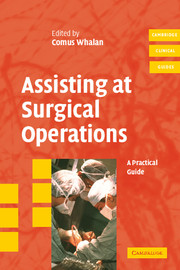Book contents
- Frontmatter
- Contents
- Contributors
- Foreword
- Preface
- PART I Introduction to the operating theatre
- 1 General conduct in the operating theatre
- 2 Universal Precautions
- 3 Clothing in the operating theatre
- 4 Personnel: who's who in the operating theatre
- PART II The operation itself
- PART III Assisting at special types of surgery
- PART IV Immediately after the operation
- Glossary
- Suggested further reading
- References
- Index
4 - Personnel: who's who in the operating theatre
Published online by Cambridge University Press: 18 December 2009
- Frontmatter
- Contents
- Contributors
- Foreword
- Preface
- PART I Introduction to the operating theatre
- 1 General conduct in the operating theatre
- 2 Universal Precautions
- 3 Clothing in the operating theatre
- 4 Personnel: who's who in the operating theatre
- PART II The operation itself
- PART III Assisting at special types of surgery
- PART IV Immediately after the operation
- Glossary
- Suggested further reading
- References
- Index
Summary
Because all staff in the operating theatre wear similar clothing (see Chapter 3), it can be difficult to know exactly who each person is. However, the staff can be divided into the following categories.
Doctors
These consist mostly of surgeons and anaesthetists. According to their level of seniority, each of these will be consultants, registrars, residents or interns. Depending on the complexity of the operation, the most senior surgeon may either perform the operation, or assist, or simply observe. Occasionally, other doctors may also be present. For example, a paediatrician is normally present at caesarean sections, ready to look after the baby. In some hospitals, a specially trained paediatric nurse is sometimes present instead.
Nurses
Nurses are allocated specific tasks for each operation, although often they are quite capable of doing more than one of these tasks. They include the following categories.
Instrument nurses or ‘scrub nurses’
The scrub nurse's main role is to keep the surgical instruments clean and ready for use, and pass them to the surgeon promptly when needed. Scrub nurses are especially trained to pass instruments into the surgeon's (or assistant's) hand in the correct orientation so that the instrument is ready for immediate use. This is very helpful, as it means you can simply ask for an instrument, extend your hand without taking your eye off the operation, and the instrument will be placed there Scrub nurses usually know the instruments extremely well, and are understandably protective of them.
- Type
- Chapter
- Information
- Assisting at Surgical OperationsA Practical Guide, pp. 16 - 18Publisher: Cambridge University PressPrint publication year: 2006

